
31 Jul At Play With Perspective
Painter Mike Piggott’s work, like poetry, demands a second look. And even a third. His compressed kinetic energy flattens out across the canvas, conveying calmness, like that before a storm. He kidnaps images, then reunites them like babies switched at birth.
In his painting Silence, thin vestiges of an aspen forest shadow their way across a smooth winter landscape, and the wavering lines of interrupted moonlight wiggle with the changes in topography. That’s fine. But there are too many shadows and not enough trees. It is discomforting and thoughtful, unstable and inviting. An alien landscape in which everything seems familiar.
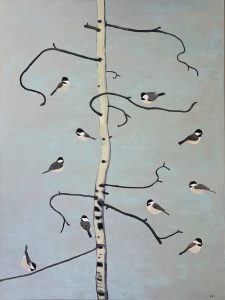
Chickadees on an Aspen | OIL ON CANVAS | 48 X 36 INCHES
“My grandfather was an artist for National Geographic and lived right outside of D.C. on a simple farm setup. They had a gigantic picture window that looked out into the forest,” Piggott says, adding that the home was decorated with stuffed birds, animal heads, and anything natural. “We spent a lot of time there on the weekends collecting firewood and plants. I was a hunter- gatherer of sorts, bringing back mountain laurel to plant under the kitchen window. And I think my art comes from that lifestyle.”
Inspired by the landscapes of the West, Piggott avidly hikes and skis, and instead of using photographs for reference in his work, he takes out his sketch pad and draws. A photograph may remind him of where he was geographically, but a drawing in his own visual language tells him why he stopped in the first place. Drawing shows what made him pull over to the side of the road and ponder — to grab his mechanical pencil, no need to sharpen — and translate his thoughts to paper. “Good drawings are better than photographs; that’s maybe how my process works,” Piggott says. Field studies like this also include the immediacy of drawing, a personal shorthand. It’s an immediacy that often hides in his paintings as well. It’s there; it’s just not evident.
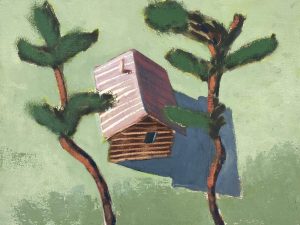
Silhouettes and Shadows | OIL ON CANVAS | 12 X 16 INCHES
“I’ll wake up, have coffee, walk in the forest, get my yayas out, and feel good about sitting all day,” he says. “Sometimes I’ll go through my Moleskin books — I carry one all the time — going over the line drawings, making references. I’ll usually have enough information to turn it into a painting within a day or two.”
Piggott’s home in Idaho’s Teton Valley brims with opportunities for subjects. “I am all over the place, I really am,” he says. “Sometimes I have a plan. This thing I want to paint — it needs to be big, and I’ll have an idea for size and scale. Other times, I look around the studio to see what empty canvases I have.”
Much of his work depends on the moment. In his painting Chickadees on an Aspen, Piggott’s bare-leafed aspen stands with its branches twirling against a complicated gray sky. Chickadees seem to float around the branches, never landing. A bit unsettling, the work might be viewed as nature painting, but it is, in fact, a defiance-of-nature painting. It is the mysterious space between the birds’ bodies and the twiggy aspen shoots that lures the eye.
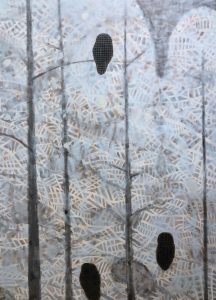
Snowy Trees and Owls |OIL ON CANVAS | 66 X 48 INCHES
“The painting is more interesting when it’s flattened out a bit; it turns into more of a design than trying to capture that ‘atmosphere’ thing,” Piggott says. “Each painting works on its own; each painting is an individual thing. I’ll respond to each one, and it is singular. Sometimes, it’s more graphic and design-y.”
In Snowy Trees and Owls, the patterns and lines, the webs of leaves and underbrush, act as a barrier for owls. The shapes and colors make us think winter in an intentional play on perspective. But there is no snow, no darkly laden clouds overhead. Everything is implied. Like a whispered hint in your ear, you understand the cold.
“I paint all the time,” Piggott says. “Being an artist is the hardest job in the world; people think it’s easy, but it’s not. I work, work, work, and look, look, look, then edit, edit, edit.”
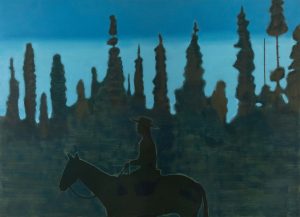
Almost Home | OIL ON CANVAS | 48 X 66 INCHES
It’s not that he’s in front of the easel all the time, although he probably is; it’s more that his mind is constantly engaged with the work he’s done and yet to do. “I wake up and know exactly what to do with that painting that’s been leaning against the wall for six months,” he says. “I’d like to say I plan; in summer, I’d like to do some paintings of the Tetons. But then, I’ll be out to dinner, and there’s a flower in a vase next to a plate with crumbs on it, and that’s what I want to paint. When I follow my energy and my interest, it seems to serve me well.”
Sharing his love of artists and art history with the intimacy of old family friends, he begins by describing the spontaneity of Spanish painter Diego Velázquez, the flat jazzy spaces of Stuart Davis, and the still-life paintings of Wayne Thiebaud. He loves Henri Matisse, Richard Diebenkorn, and Henri Fantin-Latour, and appreciates the accessibility of David Hockney. Piggott’s immersion in art and the influences that pop into his work are not accidents.
Maybe it’s the way he follows his energy or the way his mind follows the course of the world, but changing mediums is like changing his shirt. Piggott uses what works best. “My favorite is oil because you can really work on it, come back to it, and change things around. On the other hand, acrylics are fast,” he says. “Something else I’ve been working with is acrylic gouache. It has that matte look, and once it dries, it’s bulletproof. But, I so love oils; I like to use a slow-drying medium.”
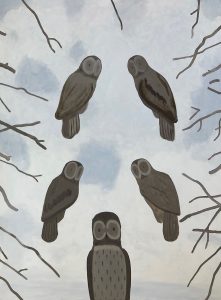
5 Owls | OIL ON CANVAS | 48 X 36 INCHES
As for canvases, he uses smooth linen and rough burlap. “Through experimentation, I am exposed to more,” he says. “People are responsive to whatever I’m doing. I’ll make an Instagram post, and people will comment and say, ‘Right away, I knew it was Piggott.’ I take that as a compliment.”
An invocation of joy mixed with a tickle of inspiration could describe Piggott’s work. Or, as he puts it, a “whoop-de-doo,” when he finds himself making gestures that, like a divining rod, discover the energy that’s present.
“For example, I have one that’s wacky,” Piggott says. It’s a garden scene loosely about spring. In the grass are a Rocket Pop popsicle and a watermelon. “My imagination will just put something in. I give myself the freedom to follow my first response. And I enjoy myself.”
At the Maya Frodeman Gallery in Jackson, Wyoming, formerly the Tayloe Piggott Gallery, where he’s shown for 25 years, Piggott has a devoted following. As the gallery’s director, Katie Franklin Cohn, puts it, “Mike Piggott helped found the gallery with Tayloe, his ex-wife.” The Tayloe Piggott Gallery sold to Alexis Dittmer in October of 2022, rebranding to the Maya Frodeman Gallery and adding jewelry as well as artists to the roster.
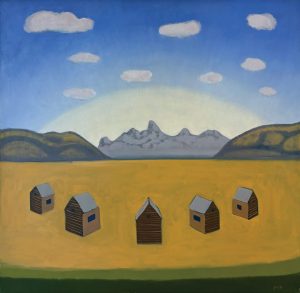
Five Cabins |OIL ON CANVAS | 36 X 36 INCHES
Both Maya Frodeman and Cohn have enjoyed a close relationship with Piggott ever since Frodeman took over the gallery. “At his heart, he is an incredible painter with an incredible view of the world,” Cohn says. “He has a heightened sense for seeing things others might overlook. He finds things of interest and things of beauty everywhere.”
Cohn’s favorite works by Piggott depict sticks of butter. In one iteration, titled Butter, the butter is thick, and a smaller slice sits apart from it, bent in askance. The background is dark, with the Spanish still-life lack of context, which introduces the mysteriousness of the spirit. After a moment, we no longer think of butter but instead are contemplating so many other things.
“I love the sticks of butter,” Cohn says. “Each one is its own amazing universe. He is often honing his own personal style. He’s really playful with his paintings but very serious about it.”
Piggott is currently experimenting with making art on his iPhone using an app called Brushes. “These really come across like drawings à la Hockney,” she says. “I love the art elements that creep into his oil paintings; they are very graphic.”
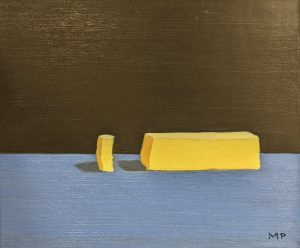
Butter | OIL ON CANVAS | 10 X 12 INCHES
Piggott’s next show at the Maya Frodeman Gallery — a retrospective — is scheduled for summer 2026. And his work is always on display. “I’ve sold Mike Piggotts all over the world,” Cohn says. “His paintings really capture something special about living in Jackson, and living in our time, and also transcending our time.”
Freelance art writer, teaching professor, and author Michele Corriel earned her master’s degree in art history and her doctorate in American art. She has received a number of awards for her nonfiction, as well as her poetry. Her latest book, Montana Modernists: Shifting Perceptions of Western Art (Washington State University Press, 2022), won four awards, including a national award from the Western History Association.




No Comments